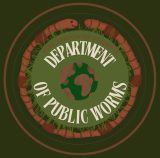The Department of Public Worms promotes composting as a great way to reduce the amount of waste you send to the landfill each day. There are several different techniques you can use at home depending on your particular situation. There are three commonly used types of composting: aerobic, anaerobic, and vermicomposting. We, at DPW, focus on aerobic or hot composting and vermicomposting.
Aerobic Composting
The method most people are familiar with, where microorganisms break down piles of organic material through aerobic (oxygen-using) processes. If enough organic material is available and if piles are adequately maintained, the decomposition processes can be quite rapid and generate a great deal of heat (hot compost). If piles are left alone or if only a small amount of organic material is available, the process will be much slower and no heat will be generated (cold composting).
*Good for those with ample time and space
Anaerobic Composting
This method is composting through fermentation. Anaerobic composting is much slower than aerobic composting and the fermentation process can cause very unpleasant odors, so DPW does not recommend this method for home composting and it will not be covered extensively here.
Vermicomposting
Is the method that uses a combination of microbes and worms, where microbes start to break down food while the worms predate on the microbes. As with aerobic composting, oxygen is a critical component of the process because worms breathe too; however, worms do not like heat and need a moderate temperature (around 70° Fahrenheit). There are advantages of worm composting such as the variety of options including small and large-scale bins, lack of odors, and mobility.
*Small-scale bins are good for those who want to compost, yet do not have a lot of time or space
*Large-scale bins are good for those with more time and want to put more effort into building their bins
We have developed some useful guides to help you get started or improve your own at-home composting systems. If you have any additional questions, don’t hesitate to contact us!
Which System Should I Use?
Aerobic composting is ideal for large or highly variable amount of yard waste and all food scraps other than meat or dairy. It requires a small amount (3 foot x 3 foot) of outdoor space, and unless you plan to purchase or build an enclosed compost tumbler, that space should be open to the dirt below (no cement patios – this creates a barrier between the naturally occurring bacteria and fungi). It works best with larger volumes of waste (when the 3 foot by 3 foot space can be filled with a 3 foot high pile) and regular (1-2 times weekly) maintenance, but can be done with less. It will produce good quality compost that can be used in the garden.
Vermicomposting is a better fit for small-scale kitchen scrap composting and can be done either outdoors or indoors if maintained properly – yard space is not mandatory! Only fruit and vegetables should be composted, with the exception of citrus, onions, and spicy foods. Worms also do not process meat, dairy, oils or grains; animal products can attract the wrong bugs and pests while grains will create alcohol through fermentation. Worm bins should generally be checked or fed weekly, though it can be left alone for up to a month. Finished worm castings are much finer than finished aerobic compost, and are much denser in nutrients (Nitrogen in particular).
